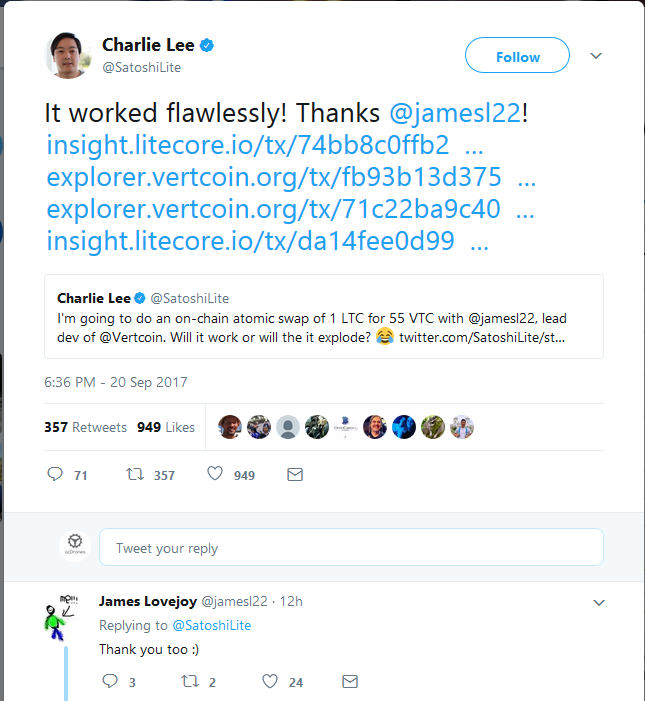Everybody in crypto world heard about these horrid stories of cryptocurrency exchanges being hacked and people losing money. Exchanges are centralized and a point of weakness. Getting rid of them the way they are now, would be a huge leap forward for crypto world. And we are closer than you think to doing exactly that.
Solution is instant trades between crypto currencies. And that is called atomic swap. And that is actually already happening – vertcoin for litecoin. Guys from VTC sent 55 VTC to Charlie Lee for 1 LTC. And it worked.
Definition of atomic swap:
“Also known as atomic cross-chain swaps, the technology essentially allows two people holding tokens on two different blockchains to trade directly – and instantly – without the risk of one party running off with the other’s money before the trade is complete.”
In computer programming, atomic denotes a unitary action or object that is indivisible, unchangeable, whole, and irreducible.
So, atomic swap means that the trade either completes in full or it is cancelled and doesn’t happen and both users get their coins back.
[thrive_leads id=’579′]
What do we need for this to work between, say BTC and LTC?
This part is edited – thanks to Andreas A. and Jason from Komodoplatform for correction:
“We needed Segwit, which is now activated. Atomic swaps (and Lightning Network payment channels) are now both possible because you can construct transactions that cannot be malleated by a third party. Atomic Swaps are possible on bitcoin too, right now.” – Andreas A.
“It is incorrect to say that Bitcoin needs Lightning Network to do atomic swaps. Bitcoin already has everything necessary to do atomic swaps. If interested check out Tier Nolan 2013 post on atomic swap protocol.” – Jason
“So long as the chains can support the same cryptographic hash function, it is possible to make transactions across blockchains without trust in 3rd party custodians.”
So what is atomic swapping all about?
Shortly put it makes coins directly convertable with zero fee and no exchange needed. You can swap coins directly and in the privacy of your own wallet.
The 2 transacting parties agree on an exchange rate beforehand. Then they both use private keys to sign a copy of the transaction.
You might think using an atomic swap requires a certain degree of trust, but that is not really so. Atomic swap is using a hashed time-locked contract, which is a part of the scripting language used for most major cryptocurrencies in existence right now. It has been added to Bitcoin Core on proposal of Peter Todd, a well known bitcoin developer.
Essentially, it allows users to create a bitcoin transaction of which the transaction outputs are spendable only at some point in the future. As such, the bitcoin sent in that transaction are time-locked until either a specified date, or until a certain number of blocks has been mined.
Both users submit transactions to both blockchains: one on Vertcoin and one on Litecoin. The Litecoin transaction sends 1 LTC from Charlie to Vertcoin team, but Vertcoin can only claim this LTC if they reveal a secret number only they know.
The Vertcoin transaction sends 55 VTC from Vertcoin to Charlie, but requires the same secret number on both chains.

Another team that did atomic swaps is Komodo – KMD. They use hosted nodes, named “Electrum” servers which allow users to interact with the cryptocurrency at hand without having to download and broadcast the whole blockchain.
Yes, our #SVP #atomicswap works with $LTC too. Over 50 coins can be direct-traded! pic.twitter.com/YXcauVJWA1
— $KMD (@KomodoPlatform) September 23, 2017
Also, Decred – DCR. Users can already begin performing exchanges between DCR, BTC and LTC using tools that the Decred developers have created.
When will it be possible on Bitcoin?
As we already said above, it is already possible. See above.
What does this mean for cryptocurrencies?
This is huge step forward. Direct atomic swaps would greatly reduce transaction fees, and remove the risk of holding large amounts of capital on exchanges. Combined with the lighting network this could enable external and merchant services where you could pay with any coin you want but the merchant gets another coin that it accepts.
Cryptocurrency enthusiasts paint a picture of atomic swaps and interoperable blockchains as the future of finance.
Would you be interested in reading about some new coins that entered the market in December and January? If yes, we recommend our articles on:
CND cryptocurrency – ICON cryptocurrency – LEND cryptocurrency. Or take a look at our selection of top coins to invest in for 2018.








Komodo Platform has already completed a BTC -LTC Atomic Swap.
It is incorrect to say that Bitcoin needs Lightning Network to do atomic swaps. Bitcoin already has everything necessary to do atomic swaps. If interested check out Tier Nolan 2013 post on atomic swap protocol.
If you have any questions and would like to know more about the state of atomic swaps ( Komodo already has completed thousands of swaps among dozens of different coin pairs ) feel free to email me.